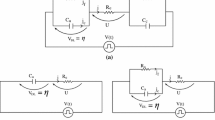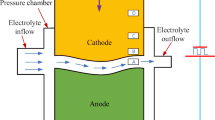Abstract
Simulation of the Pulse Electrochemical Machining (PECM) process can provide information on system design and guidelines for practical use. The pulses that are applied to the PECM system have to be described on a time scale that can be orders of magnitude smaller than the physical time scales in the system. If the full detail of the applied pulses has to be taken into account, the time accurate calculation of the variable distribution evolutions in PECM can become a computationally very expensive procedure. In previous work of the authors, approximate techniques were introduced: the hybrid calculation and the Quasi Steady State Shortcut (QSSSC). In other previous work of the authors a model for PECM of steel in NaNO3 was introduced. This model contains a changing polarization behaviour of the double layer as a function of the metal ion surface concentration, which brings a strong non-linearity in the system. In this paper a technique is introduced to integrate the non-linear model into the approximate methods. To achieve this, the strategy of the approximate methods is extended. For the QSSSC, the non-linearity is handled using an extra convergence level. For the hybrid calculation, live averaging is used to take care of the non-linear effects. Performing this, the timesteps used during the high level calculations are no longer dictated by the pulse characteristics. Using this approach, computationally very cheap, yet satisfying results can be obtained. The technique is very general and very powerful and can be used in any multi-timescale system.











Similar content being viewed by others
Abbreviations
- a :
-
Polarization parameter 1 (S m−2);
- A :
-
Electrode surface (m2);
- b :
-
Polarization parameter 2 (A m−2);
- c :
-
Concentration (mol m−3);
- C p :
-
Heat capacity (J kg−1 K−1)
- D :
-
Diffusion coefficient (m2s−1)
- E 0 :
-
Equilibrium potential (V)
- F :
-
Faraday constant (= 96485 C mol−1)
- h :
-
Heat transfer coefficient (W m−2 K−1)
- I :
-
Electrical current (A)
- J :
-
Current density distribution (A m−2)
- k :
-
Thermal conductivity (W m−1 K−1)
- P dl :
-
Heat produced, in the double layer (W m−2)
- P bulk :
-
Heat produced in the bulk (W m−3)
- Pr t :
-
Turbulent Prandtl number (–)
- \(\overline{r}\) :
-
General location vector (m)
- Re :
-
Reynolds number (–)
- t :
-
Time (s)
- T :
-
Pulse period (s)
- U :
-
Potential distribution (V)
- v :
-
Velocity (m s−1)
- w :
-
Water depletion factor (–)
- x :
-
Distance (m)
- z :
-
Valence (–)
- α:
-
Duty cycle (–)
- η:
-
Overpotential (V)
- \(\Uptheta\) :
-
Temperature (K)
- μ:
-
Dynamic viscosity (kg m−1 s−1)
- ρ:
-
Density (kg m−3)
- σ:
-
Electrical conductivity (S m−1)
- τ:
-
Time constant (s)
- \(\Upphi_c\) :
-
Mass flux (mol s−1m−2)
- ψ:
-
Pulse delay (s)
- ψ*:
-
Optimal pulse delay (s)
- 2D:
-
two dimensional
- DC:
-
Direct current
- DNS:
-
Direct numerical simulation
- ECM:
-
Electrochemical machining
- FEM:
-
Finite elements method
- PAP:
-
Prior averaging pulse
- PECM:
-
Pulse electrochemical machining
- QSS:
-
Quasi steady state
- QSSSC:
-
Quasi steady state shortcut
- RANS:
-
Reynolds averaged Navier-stokes
- SS:
-
Steady state
References
Boehlke T, Foerster R (2006) Electro chemical machining with oscillating tool electrode: estimation of maximum pressure. Int J Electr Eng 11:9–14
Bortels L, Purcar M, Van den Bossche B, Deconinck J (2004) A user-friendly simulation software tool for 3D ECM. J Mater Process Technol 149:486–492
Clark W, McGeough J (1977) Temperature distribution along the gap in electrochemical machining. J Appl Electrochem 7:277–286
Datta M, Landolt D (1981) Electrochemical machining under pulsed current conditions. Electrochim Acta 26(7):899–907
Foerster R, Schoth A, Menz W (2005) Micro-ECM for production of microsystems with a high aspect ratio. Microsyst Technol 11(4–5):246–249
Kozak J (2004) Thermal models of pulse electrochemical machining. Bulletin of the polish academy of sciences. Tech Sci 52(4):313–320
Kozak J, Rajurkar K (1991) Computer simulation of pulse electrochemical machining (PECM). J Mater Process Technol 28(1–2):149–157
Kozak J, Rajurkar K, Lubkowski K (1997) The study of thermal limitation of electrochemical machining process. Transac NAMRI/SME XXV:159–164
Lohrengel M, Klueppel I, Rosenkranz C, Betterman H, Schultze J (2003) Microscopic investigations of electrochemical machining of Fe in NaNO3. Electrochim Acta 48(20–22):3203–3211
Loutrel S, Cook N (1973) A theoretical model for high rate electrochemical machining. ASME J Eng Ind 95(B/4):1003–1008
Mount A, Clifton D, Howarth P, Sherlock A (2003) An integrated strategy for materials characterisation and process simulation in electrochemical machining. J Mater Process Technol 138:449–454
Nelissen G (2003) Simulation of multi-ion transport in turbulent flow. Ph.D. thesis, Vrije Universiteit Brussel, Brussels
Purcar M, Bortels L, Van den Bossche B, Deconinck J (2004) 3D electrochemical machining computer simulations. J Mater Process Technol 149:472–478
Purcar M, Dorochenkoa A, Bortels L, Deconinck J, Van den Bossche B (2008) Advanced CAD integrated approach for 3D electrochemical machining simulations. J Mater Process Technol 203:58–71
Rajurkar KP, Zhu D, McGeough JA, Kozak J, De Silva A (1999) New developments in electro-chemical machining. Ann CIRP 48(2):567–579
Smets N, Van Damme S, De Wilde D, Weyns G, Deconinck J (2007) Calculation of temperature transients in pulse electrochemical machining. J Appl Electrochem 37(3):315–324
Smets N, Van Damme S, De Wilde D, Weyns G, Deconinck J (2007) Time averaged temperature calculations in pulse electrochemical machining, part I: theoretical basis. J Appl Electrochem 37(11):1345–1355
Smets N, Van Damme S, De Wilde D, Weyns G, Deconinck J (2008) Time averaged concentration calculations in pulse electrochemical machining. J Appl Electrochem 38(11):1577–1582
Smets N, Van Damme S, De Wilde D, Weyns G, Deconinck J (2008) Time averaged temperature calculations in pulse electrochemical machining, part II: numerical simulations. J Appl Electrochem 38(4):551–560
Smets N, Van Damme S, De Wilde D, Weyns G, Deconinck J (2009) Time averaged concentration calculations in pulse electrochemical machining, spectral approach. J Appl Electrochem 39(12):2481–2488
Smets N, Van Damme S, De Wilde D, Weyns G, Deconinck J (2009) Time averaged temperature calculations in pulse electrochemical machining, spectral approach. J Appl Electrochem 39(6):791–798
Smets N, Van Damme S, De Wilde D, Weyns G, Deconinck J (2010) Comment on numerical model for predicting the efficiency behaviour during pulsed electrochemical machining of steel in NaNO3 [Van Damme S et al. (2006) J Appl Electrochem 36(1):1]. J Appl Electrochem 40(1):205–207
Van Damme S, Nelissen G, Van Den Bossche B, Deconinck J (2006) Numerical model for predicting the efficiency behaviour during pulsed electrochemical machining of steel in NaNO3. J Appl Electrochem 36(1):1–10
Author information
Authors and Affiliations
Corresponding author
Rights and permissions
About this article
Cite this article
Smets, N., Van Damme, S., De Wilde, D. et al. Time averaged calculations in pulse electrochemical machining, using a strongly non-linear model. J Appl Electrochem 40, 1395–1405 (2010). https://doi.org/10.1007/s10800-010-0116-8
Received:
Accepted:
Published:
Issue Date:
DOI: https://doi.org/10.1007/s10800-010-0116-8




